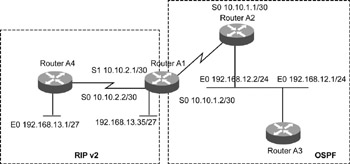Redistribution in OSPF
Care should be taken to configure redistribution into OSPF and between OSPF and another IGP. This is to prevent routing loops and suboptimal routing in the network.
Consider the example shown in Figure 9.7. The figure shows a hybrid routing environment with both RIP and OSPF routing protocols. Routers A2 and A3 are running OSPF, and A4 is running RIP. A1 is redistributing RIP routes into OSPF.

Figure 9.7: Example showing a network configured with OSPF and RIP routing protocols.
In Figure 9.7, the RIP route 192.168.13.0/24 is not available in the routing table of A3. The command A3#show ip route | inc 192.168.13.0 shows no output. To troubleshoot redistribution in this scenario:
-
Check if the route is available in A1 using the A1#show ip route | inc 192.168.13.0 command. The output generated will be as shown:
A1#show ip route | inc 192.168.13.0 R 192.168.13.0/27 [120/1] via 10.10.2.1, 00:00:16, Serial1
The output shows that the RIP route is available at A1.
-
Check if the keyword subnets is used while redistributing into OSPF. This keyword is essential, because the subject network has been subnetted. The configuration of A1 should be as shown:
router ospf 1 network 10.10.1.0 0.0.0.255 area 2 network 10.10.2.0 0.0.0.255 area 2 redistribute rip metric 10 subnets
Add the keyword if it is missing.
-
Check if the route is available in the routing table of A3, after adding the subnets keyword.
-
Check for the presence of any route map used in redistribution, if the route is unavailable. The route maps are checked as shown in Listing 9.21.
Listing 9.21 Checking for Route Maps in A1
router ospf 1 network 10.10.1.0 0.0.0.255 area 2 network 10.10.2.0 0.0.0.255 area 2 redistribute rip route-map redis-rip ! route-map redis-rip match ip address 10 set metric 20 ! access-list 10 deny 192.168.13.0 0.0.0.31 access-list 10 permit any !
Listing 9.21 shows the presence of a route map that is restricting the redistribution of network 192.168.13.0/27 into OSPF. The route map is suitably modified.
-
Check if there is any filtering of updates at A3 if there are no route maps. In the case of OSPF, we need to check for route filtering only at A3, because no outbound filtering is possible. Filtering updates are verified using the show ip protocols command. Listing 9.22 shows the output of the show ip protocols command.
Listing 9.22 Output of the show ip protocols Command at A3
A3#show ip protocols Routing Protocol is "ospf 1" Outgoing update filter list for all interfaces is not set Incoming update filter list for all interfaces is not set Ethernet0 filtered by 15 (per-user), default is 15 Router ID 192.168.12.1 Number of areas in this router is 1. 1 normal 0 stub 0 nssa Maximum path: 6 Routing for Networks: 192.168.12.0 0.0.0.255 area 5 Passive Interface(s): Routing Information Sources: Gateway Distance Last Update 192.168.12.2 110 00:00:00 Distance: (default is 110)
Listing 9.22 shows that access list 15 is used to filter incoming routing updates into A3. The output of the A3#show running-config | inc access-list 15 command is as shown:
access-list 15 deny 192.168.13.0 0.0.0.31 access-list 15 permit any
Route filtering is disabled or access list 15 is suitably modified to make route 192.168.13.0/27 available in the routing table of A3.
EAN: 2147483647
Pages: 130